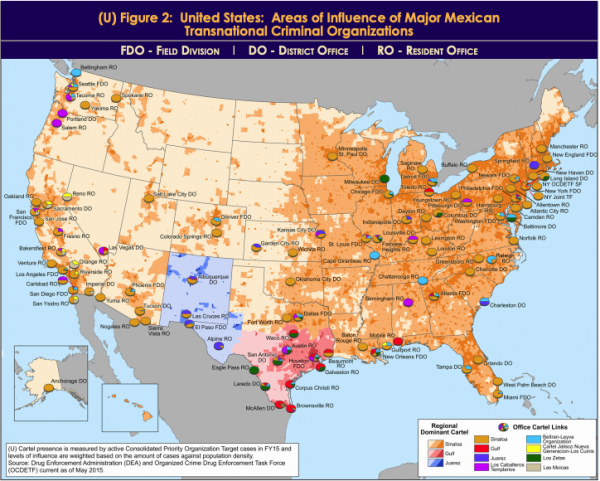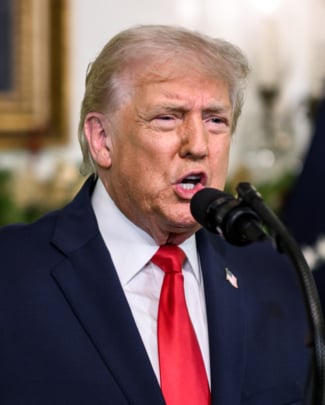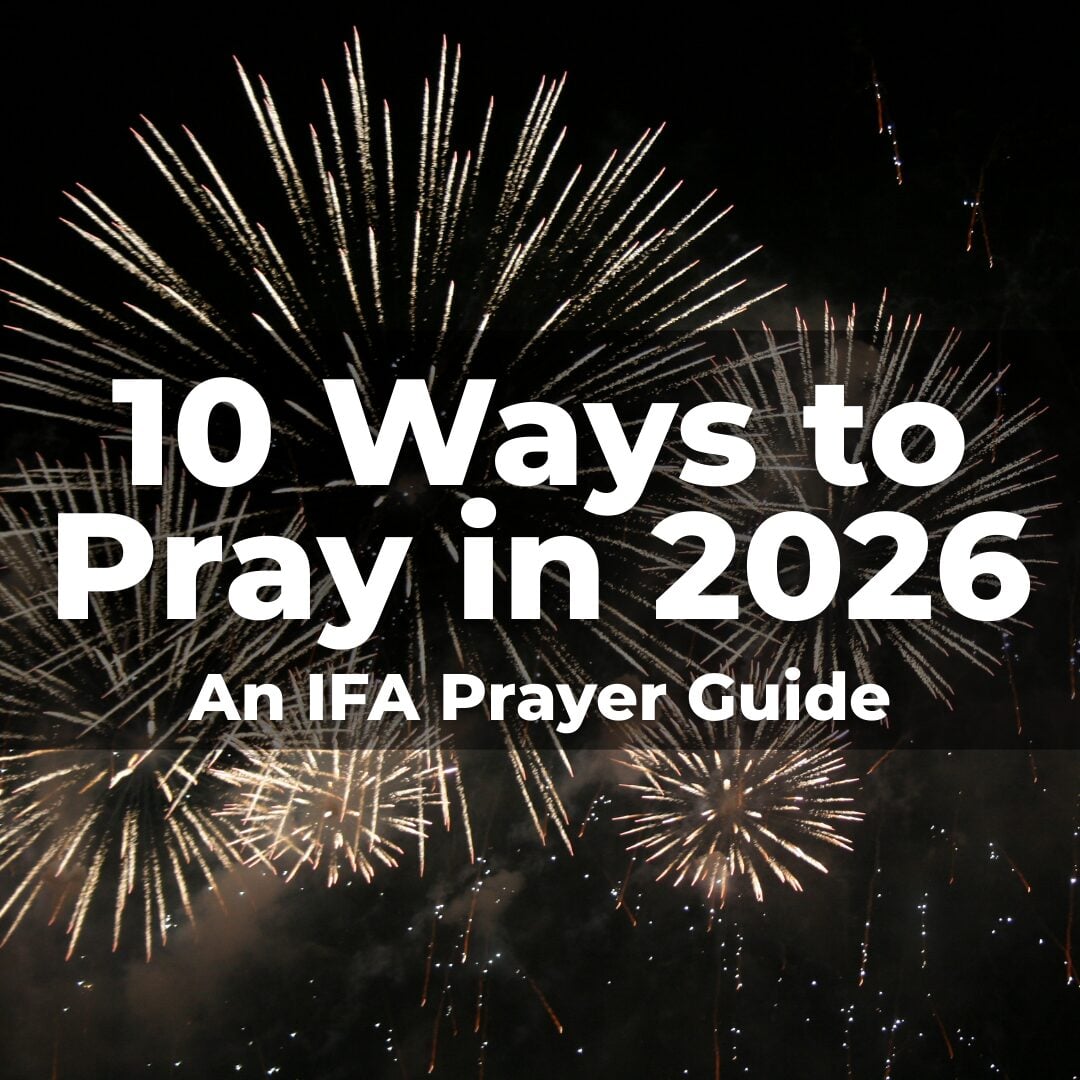TEXAS SHERIFF SAYS IT’S THE CARTELS THAT BENEFIT FROM THE BORDER PROBLEM, NOT ASYLUM SEEKERS
MAINE PASSES BILLS FUNDING OF ABORTION AND MANDATING VACCINATIONS WITHOUT...
STUDENT FORCED TO RECITE ‘MUSLIM CONVERSION PLEDGE’ APPEALS TO SUPREME...
MOVING FROM PROPHETIC POTENTIAL TO APOSTOLIC ADMINISTRATION
CHILDREN’S CARTOON ‘ARTHUR’ FEATURES A GAY WEDDING
TEXAS SHERIFF SAYS IT’S THE CARTELS THAT BENEFIT FROM THE BORDER PROBLEM, NOT ASYLUM SEEKERS
WASHINGTON—A porous southwest border is the gift that keeps on giving to Mexican cartels, whose multibillion-dollar businesses depend solely upon getting illicit goods into the United States.
Sheriff Andy Louderback of Jackson County, Texas, said border security efforts need to focus more on disrupting the cartels.
“The cartels remain at the heart of the problem here in the United States. They have unlimited funding. … They’re very good at what they do. They’re very powerful, very powerful, in this country,” he said.
Louderback said the cartels are exploiting weak borders and are “profiting hugely off human misery in this country—profiting off of Americans.”
“It’s imperative that the American public understand the criminality of what we’re facing. That alone is enough to secure the border,” he said.
YOU CAN PRAY WITH DIRECTION AND STRATEGY USING IFA’S “CRISIS AT THE BORDER”
SPECIAL REPORT. CLICK BELOW TO DOWNLOAD YOUR FREE COPY.
Mexican cartels, otherwise known as transnational criminal organizations (TCOs), show continued signs of growth in the United States, according to the Drug Enforcement Administration (DEA) in a 2018 report.
The cartels control lucrative smuggling corridors, primarily across the southwest border, and maintain the greatest drug-trafficking influence in the United States, states the DEA.
“They continue to expand their criminal influence by engaging in business alliances with other TCOs, including independent TCOs, and work in conjunction with transnational gangs, U.S.-based street gangs, prison gangs, and Asian money laundering organizations,” the DEA said.
Almost 90 percent of the heroin in the United States comes from Mexico, according to the DEA, and Mexican heroin production grew by 37 percent from 2016 to 2017.
“Mexican cartels continue to make large quantities of cheap methamphetamine and deliver it to the United States through the southern border,” the DEA said. Seizures of meth at the border increased from 8,900 pounds in 2010 to more than 82,000 pounds in 2018.
The cartels also export significant quantities of cocaine, marijuana, and fentanyl into the United States.
“The drugs are delivered to user markets in the United States through transportation routes and distribution cells that are managed or influenced by Mexican TCOs, and with the cooperation and participation of local street gangs,” the DEA report states.
“Illicit drugs, as well as the transnational and domestic criminal organizations that traffic them, continue to represent significant threats to public health, law enforcement, and national security in the United States.”
Most of the drugs that are seized are found in vehicles coming through ports of entry. Customs and Border Protection officials seized the largest amount of fentanyl being smuggled in a truck through the Nogales, Arizona, port of entry on Jan. 26.
A Mexican national was arrested after officers found nearly 254 pounds of fentanyl valued at approximately $3.5 million and almost 395 pounds of methamphetamine valued at $1.1 million. That amount of fentanyl had the potential to kill 56 million people, based on the DEA’s estimation that ingesting as little as 2 milligrams of fentanyl, equivalent to a few grains of salt, can be fatal.
But cartels are also using the large groups of asylum-seekers, mostly from Central America, to tie up Border Patrol resources in areas along the border.
“In many instances, criminal organizations are saturating areas with large groups with the belief that they can smuggle narcotics or other contraband into the United States while Border Patrol agents are occupied,” CBP said in a statement on Feb. 11.
Border Patrol agents have encountered more than 58 groups of 100-plus people so far this fiscal year, compared to 13 in all of fiscal 2018.
Remote Border Areas
A civilian group in Arivaca, Arizona, sets up hidden trail cameras on the border in a remote area where it’s rare to see Border Patrol, and the fence, where it exists, is merely four-strand barbed wire.
Arizona Border Recon’s trail camera footage is eye-opening—groups of eight to 10 people crossing the border in camo gear, humping backpacks, and trekking purposefully northwards, deeper into the United States, in carpet shoes to hide their tracks.
The group’s founder, Tim Foley, said that in an average two-week period, one camera on just one of the hundreds of branching trails picked up 400 illegal aliens and 100 drug mules—all led by “coyotes,” or smugglers.
Cartel scouts sit on the mountaintops on both the Mexican and U.S. sides, as if they are air-traffic controllers, ensuring safe passage through.
“About a year ago, our cameras quit picking up the burlap sacks with the 20 kilos of marijuana, but now we’re seeing that they’re running a bigger camouflage pack than the regular illegals,” Foley said in December. “It’s better made. More space in it. They’re running meth, heroin, cocaine, fentanyl.”
Foley hopes to add to his eight trail cameras and continue to pass information on to Border Patrol.
“Cartels are basically the Hispanic version of ISIS,” he said. “We’ve got enough of our own bad guys. We don’t need to import more.”
National Emergency
President Donald Trump signed an executive order three weeks after taking office, instructing federal law enforcement to go after cartels.
“These groups are drivers of crime, corruption, violence, and misery,” the order states. “In particular, the trafficking by cartels of controlled substances has triggered a resurgence in deadly drug abuse and a corresponding rise in violent crime related to drugs. Likewise, the trafficking and smuggling of human beings by transnational criminal groups risks creating a humanitarian crisis.”
On Feb. 15, the president announced a national emergency after Congress failed to provide the $5.7 billion he was asking for to erect 234 miles of fencing requested by the Department of Homeland Security.
Congress provided $1.375 billion toward border fencing, and Trump intends to supplement that with $6.1 billion of reappropriated defense funds.
“We have a State of Emergency at our Southern Border,” Trump wrote on Twitter on Feb. 25. “Border Patrol, our Military and local Law Enforcement are doing a great job, but without the Wall, which is now under major construction, you cannot have Border Security. Drugs, Gangs and Human Trafficking must be stopped!”
Louderback said he supports Trump calling a national emergency to get more border fencing in place.
“The saying is, you build a 10-foot wall, you provide an 11-foot ladder. I got that, and many of us do. Can we inhibit, slow, and catch … by putting in infrastructure in certain places on our southern border? The answer’s absolutely yes,” he said.
“Are there going to be folks that tunnel under? Certainly. Are there going to be ones that climb over? Certainly. Is there going to be fewer? Absolutely. The expectations are, when you put the infrastructure there, that you’re going to do a better job of controlling that piece of real estate.
“If you’re able just to walk across, that’s not operational control of our border.”
‘El Chapo’
The recent trial and conviction of Joaquin “El Chapo” Guzman provided an insight into the Sinaloa Cartel.
Guzman oversaw the smuggling of narcotics to wholesale distributors in Arizona, Atlanta, Chicago, Los Angeles, Miami, New York, and elsewhere, according to the Department of Justice (DOJ).
The billions of illicit dollars generated from drug sales in the United States were then clandestinely transported back to Mexico, the DOJ said.
“Guzman also used ‘sicarios,’ or hit men, who carried out hundreds of acts of violence in Mexico to enforce Sinaloa’s control of territories and to eliminate those who posed a threat to the Sinaloa Cartel,” the DOJ said in a statement.
A witness at the trial, Alex Cifuentes, who said he used to be Guzman’s right-hand man, told the court that Guzman paid a $100 million bribe to former Mexican President Enrique Peña Nieto.
On Feb. 21, the DOJ announced indictments against two of Guzman’s sons—Joaquin Guzman Lopez, 34, and Ovidio Guzman Lopez, 28—on drug conspiracy charges.
“The rise of the cartel power, their ability to penetrate our border, their ability to move fluidly and silently in any different direction with a 10-minute phone call to make massive changes in what they’re doing, to reroute a load, to reroute humans. … This is the kind of flexibility and the kind of enemy that we’re actually dealing with here,” Louderback said.
“You know who doesn’t want border security, who doesn’t want a wall? And that’s certainly your drug cartels, that’s certainly your MS-13, that’s your rapist, that’s your drug dealers, and sadly, some Democrats that do not want a wall.
“They don’t want operational control of our border. And that’s very sad. It’s tragic and it’s sad. It costs American lives.”
Louderback said the problem exists in every state, but the solution has to start with border security. Once the United States has control over its southern border, it will take full cooperation between federal, state, and local law enforcement to decimate the cartels.

The 6 Main Cartels Active in the US
The DEA identifies six cartels that traffic the most drugs into the United States: Sinaloa Cartel, Cartel Jalisco Nueva Generacion (CJNG), Juarez Cartel, Gulf Cartel, Los Zetas Cartel, and Beltran-Leyva Organization (BLO).
The Sinaloa Cartel maintains the most expansive footprint in the United States, while CJNG’s domestic presence has significantly expanded in the past few years, according to the DEA. Although 2017 drug-related murders in Mexico surpassed previous levels of violence, U.S.-based cartel members generally refrain from extending inter-cartel conflicts domestically.
Sinaloa Cartel
- Based in the state of Sinaloa.
- One of the oldest and more established drug trafficking organizations in Mexico.
- Controls drug trafficking activity in various regions in Mexico, particularly along the Pacific Coast.
- Exports and distributes wholesale amounts of methamphetamine, marijuana, cocaine, heroin, and fentanyl.
- Has distribution hubs in Phoenix, Los Angeles, Denver, and Chicago.
- Illicit drugs primarily smuggled through crossing points along Mexico’s border with California, Arizona, New Mexico, and west Texas.
Jalisco New Generation Cartel (CJNG)
- Based in the city of Guadalajara in the state of Jalisco.
- The most recently formed of the six and one of the most powerful and fastest-growing cartels.
- Rapid expansion due to willingness to engage in violent confrontations with Mexican government security forces and rival cartels.
- Drug distribution hubs in Los Angeles, New York, Chicago, and Atlanta.
- Smuggles illicit drugs using various trafficking corridors along the southern border to include Tijuana, Juarez, and Nuevo Laredo.
- Manufactures and/or distributes large amounts of cocaine, heroin, methamphetamine, and fentanyl.
Juarez Cartel
- Operates in the Mexican state of Chihuahua, south of west Texas, and New Mexico.
- One of the older Mexican cartels.
- Endured a multi-year turf war with Sinaloa Cartel, which, at its height in mid-2010, resulted in many drug-related murders in Chihuahua.
- Supplies drug markets primarily in El Paso, Denver, Chicago, and Oklahoma City.
- Mainly trafficks marijuana and cocaine, though recently, it has expanded to heroin and methamphetamine.
- Recent significant increase in opium cultivation.
Gulf Cartel
- Based in the state of Tamaulipas
- In operation for decades
- Trafficks mostly marijuana and cocaine, but has also recently expanded into heroin and methamphetamine.
- Smuggles drugs mostly into south Texas between the Rio Grande Valley and South Padre Island.
- Maintains a presence in Atlanta, and holds key distribution hubs in Houston and Detroit.
Los Zetas Cartel
- Base of power is in Nuevo Laredo, Mexico.
- Formed in early 2010 after splintering from the Gulf Cartel.
- Currently divided into two rival factions: the Northeast Cartel (Cartel del Noreste, or CDN), representing a rebranded form of mainstream Zetas, and the Old School Zetas (Escuela Vieja or EV), which is a breakaway group.
- Smuggle drugs primarily into Texas between Del Rio and Falcon Lake.
- Trafficks cocaine, heroin, methamphetamine, and marijuana.
- Key distribution hubs in Laredo, Dallas, and New Orleans, and a known presence in Atlanta.
Beltran-Leyva Organization (BLO)
- Asserted independence after a split from Sinaloa in 2008.
- Remnants of the cartel operate in various parts of Mexico, including the states of Guerrero, Morelos, Nayarit, and Sinaloa.
- Most prominent subgroup, Los Guerreros Unidos, operates independently due to its role in the heroin trade.
- BLO subgroups rely on their loose alliances with CJNG, the Juarez Cartel, and Los Zetas for access to drug smuggling corridors along the southern border.
- Primarily trafficks marijuana, cocaine, heroin, and methamphetamine.
- Distribution hubs in Phoenix, Los Angeles, Chicago, and Atlanta.
(Excerpted from The Epoch Times, article by Charlotte Cuthbertson)
Partner with Us
Intercessors for America is the trusted resource for millions of people across the United States committed to praying for our nation. If you have benefited from IFA's resources and community, please consider joining us as a monthly support partner. As a 501(c)3 organization, it's through your support that all this possible.


We use cookies to ensure that we give you the best experience on our website. If you continue to use this site we will assume that you are happy with it. Privacy Policy




Comments
Lord Jesus,
You see this evil cancer that is infecting this country. I second all the prayers from above to step on the jugular vein of the cartel operations. As you caused the Assyrians confusion in their ranks and they killed each other to show your strength to Gideon and his 300 warriors, Lord, cause confusion in the ranks of these evil cartel operations so that they cannot function. Expose them, neuter them, and allow your Holy Spirit victory.
Awesome Lord thank You for my sister Krista I come in agreement with her mastering of Your Word in this intercession. I thank You God for rooting out all evil from the United States of America’s borders. I ask for these Cartels to repent and be delivered and saved, You did it to Paul when You turned him from Saul and You can do it again. Nothing is impossible with You. What is too hard for us is not too hard for You. We cry Jeremiah 33:3 for the President and for all who are working with him. and ask that the parties come into agreement for strength and breakthrough in Jesus name I pray in agreement with the saints. Amen.
Jehovah Gibbor Milchamah, The Lord Mighty In Battle: The Lord is my strength and song and He has become my salvation, this is my God and I will praise Him; my father’s God and I will extol Him. The Lord is warrior; the Lord is His name. Pharaoh’s chariots and his army He has cast into the sea; and the choicest of his officers are drowned in the Red Sea. The deeps cover them; they went down into the depths like a stone. Your right had, O Lord, is majestic in power, Your right hand, O Lord, shatters the enemy. And in the greatness of Your excellence You overthrow those who rise up against You. Exodus 15:2-7
Amen.